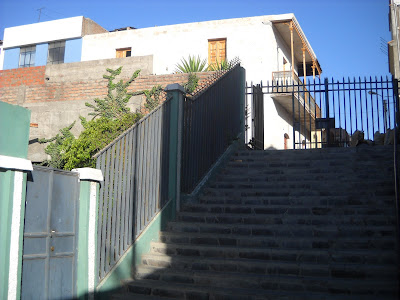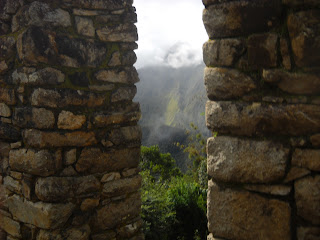I've been to a fair number of lost cities recovered from the wilds, and most, in fact, all of them, have offered me some interesting and often times unique insights into the ways of humanity that are, for me, beyond my experience in the modern world. Often times I am transported, if only in my imagination, to past times and am allowed experience of other ways of living that I can't get from reading or imagining on my own in the privacy of my own space; but in a setting far from the usual, in a place where I am surrounded by the exotic, then I find myself in a different state of mind altogether, at times so strange and awe inspiring that I am hooked on such adventure seeking. My time at Machu Picchu, however, was not a great experience; it was a huge let-down in that there were so many people tramping around, that the commercial aspects of the visit so over-powered any sense of the sublime, that I was put off badly and could hardly think of the place in situ let alone the hoped for and expected transport of the mind. But, having grumped about it, there will come a time when all the edges are worn off and the bright spots will shine like the sun.
At Machu Picchu I saw a marvel of human ingenuity and perseverance and imagination that is almost unrivaled in my experience. I was more or less disgusted by the initial encounter, but such will pass. I have the images of Machu Picchu vividly in my memory, the kind of deep impression that lasts and grows stronger with time. Good for me, after all. But my tooth. I was in trouble and needed help, which I couldn't act on at such altitude. I could hardly breathe at Cuzco when I returned, it being even higher up than Macchu Pichu itself.
I went for a consultation with a dentist, who just happens to be the most beautiful woman I have seen in Peru. Her name is Yerte, and not only is she young and beautiful and delicate and lovely, she wrote out a persciption for antibiotics and antiinflamtory drugs to get me within spitting distance of health. I had to get to a lower elevation, which I did by hopping a bus to Arequipa, some 12 hours south. At 6,000 feet I am in the safety zone, more or less. I've been a week now on the medicines, and will continue my way south from here. But I have had a week to look around Arequipa, a city I enjoy to some extent, though in many ways I am forced to consider that the people here are of a different race from those of Lima, a race not so pleasant that I feel any desire to stay here longer.

In many ways this is a 19th Century city, but here there is electricity and endless imported consumer goods for sale in shops on every street, some shops selling stuff so obscure I can't describe it. What can one say of a shop filled with metal bits that make no sense to the average man? It must be for something, though I can't place metal bits as anything useful. Perhaps it's for some repair job I have never seen before. But other shops sell things universal, shoes, plastic goods, Chinese food.
Often I just wander around looking at this anachronistic city. There must be something this city produces, but it escapes me. So far from the centre of things, from Lima and the manufacturing and exports on the coast, and so far from the handicrafts economy for tourists that one finds in the Machu Picchu area. I have no idea what sustains this place. People have enough money to buy everything a people could need in our time, and I see only a few homeless men, obviously mentally deranged, and I see many people well-dressed and well-fed. It's not rich here, but stable and livable. It should be a good place. I find I don't like it at all as much as I hoped I would. On the surface it looks just about right.
I took a short walk to the river here, and on the way saw what seemed like a happy middle class area of smart looking houses and a well-tended homes.
The street is off the beaten track, the fronts looking clean and healthy.
But behind the houses I found the ruin of ages.
The stench of sewage behind the facade was unbearable.
But, like so much of this nation, the facade is as deceptive as the seeming disgusting reality behind it: I found a super market here that is a delight to my mind, a place a block in size and a beauty like a cheap Walmart. Food, food, food, and clothing and housewares and electronics and endless delights of the Modern age. All of it cheap and clean and new. I am in love with such places, the sign of the future when every man can live in peace and plenty. Vea. I see. I see the future. It is beautiful.











































